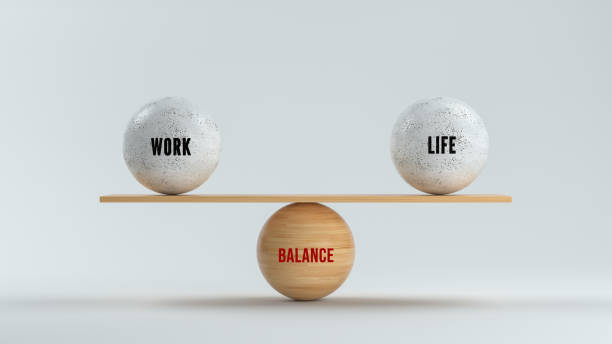It’s a new work week Workster… another chance to get up and go after your goals as the year draws slowly (or not) to a close
A new week with several opportunities for growth, new projects, collaborations, and clients. But as we look to make the most of the new week, I think we should also consider one phrase we’ve probably heard thousands of times in the past few years: “work-life balance”. But then, this term has been thrown around so much that I daresay it might have lost its meaning.

Yet, when your home is your office–as is for most of us– and your clients span different time zones, finding that sweet spot between professional success and personal overall well-being isn’t just a luxury—it’s essential for survival.
In spite of this, why does it seem like many freelancers struggle with the idea of work-life balance?
Why Freelancers Struggle with Work-Life Balance
The freelance lifestyle promises flexibility and freedom, but many times, we find ourselves working long hours, perhaps longer than some of our 9-to-5 counterparts, and here’s why:
Irregular Income Creates Pressure
– Fear of feast-or-famine cycles leads to overworking during busy periods and sometimes worrying during periods with fewer projects.
– Difficulty saying “no” to projects due to financial uncertainty: As freelancers, there are times when we know our plates are full and we can’t take on any more… but yet we still do, especially after taking a peek at the client’s budget and a look at our books.
– Constant pressure to build a financial buffer for rainy days.
Blurred Boundaries
– Home office setup eliminates the physical separation between work and personal life: Working from the comfort of your home is amazing, infact, I daresay it is one of the top perks of this lifestyle until you realize you’re spending almost all your waking hours “working” because your home and office are in the same physical space.
– Digital devices keep us constantly connected to clients: Phones are always nearby so we don’t miss important client messages or updates, but have we ever stopped to consider the other side of this “constant digital link” we share with clients and projects?
– Difficulty “switching off” when work and living spaces overlap: Ever feel like you can’t “switch off” or take some time off because you’d return and have so much to catch up on?

Client Expectations Management
– Working with clients across different time zones.
– Pressure to be constantly available.
– Rush projects and unexpected deadlines.
Signs Your Work-Life Balance Needs Attention
Physical Indicators
– Persistent fatigue: How do you feel on a regular day? Energetic? Just fine? Lethargic? Or you just want the day to wind down so you can hit the hay and move to the next? When you feel this way, don’t just write it off and move on, this could be a sign of persistent fatigue and perhaps your signal to take things a bit slower.
– Disrupted sleep patterns: Do you pay attention to your sleep pattern at all? Or you’re a “go with the flow” Workster? Whichever category you fall into, take conscious actions to notice your sleep patterns and if it needs fixing, fix it.
– Frequent headaches or body tension.
– Irregular eating habits.
Emotional Warning Signs
– Do you experience increased irritability?
– Do you feel a tinge of guilt during downtime?
– Are you anxious about taking breaks–even for a day– from work?
– Decreased motivation.
Professional Impact
– Declining work quality.
– Missed deadlines.
– Reduced creativity.
– Client communication issues.
With these points noted, how can you create that balance and make work–and life– enjoyable again?
Creating a Sustainable Work-Life Balance: Practical Strategies
- Establish Clear Boundaries
Physical Boundaries
– Create a dedicated workspace.
– Implement a “door closed” policy during work hours.
– Keep work materials confined to your office space.
Digital Boundaries
– Make sure to set up separate work and personal devices.
– When you can, use different email addresses for business and personal life.
– Install apps that limit work-related notifications after working hours.
- Time Management Techniques
Structured Workday
– Set regular working hours.
– Use time-blocking for different activities.
– Schedule regular breaks.
– Include buffer time between tasks.
Project Management
– Use productivity tools to track time.
– Include buffer time in project timelines so you don’t overextend yourself.
– Study the project carefully and ensure you set realistic deadlines.
– Batch similar tasks together.
- Client Management Strategies
Setting Expectations
– Clearly communicate your working hours to clients.
– Separate emergency vs. non-emergency situations and respond appropriately to both.
– Establish response time guidelines.
– Create professional boundaries in contracts.
Efficient Communication
– For apps and emails, you can use automated responses outside working hours.
– Schedule regular check-ins to ensure everyone is on the same page.
– Batch client communications.
- Self-Care Practices
Physical Well-being
– Schedule regular exercise: Find an exercise routine that works for you and stick with it. Remember with exercise consistency is key.
– Plan healthy meals.
– Maintain a consistent sleep schedule.
– Take regular breaks.
Mental Health
– Practice mindfulness or meditation.
– Engage in hobbies: Find hobbies (preferably outdoor hobbies or hobbies that task your brain and do not require a digital device) that work for you and also work other skills you may not utilize too often in your line of work.
– Maintain social connections.
– Seek professional support when needed.
Long-term Sustainability Strategies
Business Systems Development
– Create a standard operating procedure for your business.
– Automate repetitive tasks: Thanks to the advancement in artificial intelligence, you can automate certain repetitive tasks in your niche, helping you free up time for other activities.
– Build a support network.
– Consider outsourcing.
Financial Planning
– Set realistic income goals.
– Build an emergency fund.
– Plan for vacation time.
– Include healthcare costs in pricing.
Professional Development
– Invest in efficiency-boosting skills.
– Learn to delegate effectively.
– Join professional communities.
– Work to develop passive income streams.
How To Create Your Personal Work-Life Balance Plan
Step 1: Assessment
The start of any introspective process, an honest assessment will help you map out what works, what doesn’t, and where changes need to be made.
Here are a few ideas that can help you→
– Track current time usage.
– Identify energy patterns.
– Note stress triggers.
– Review client relationships.
Step 2: Goal Setting
If you don’t have any targets you’re working towards, then you cannot develop or adopt a strategy to move you closer to these goals. This is why goal setting is vital and here’s how to go about it…
– Define ideal working hours.
– Set income targets.
– List personal priorities.
– Establish health goals.
Step 3: Implementation
The phase when the plan gets wheels fitted on it and starts rolling, implementation gives you a chance to find out what works and what doesn’t, and quickly adjust to suit current realities.
– Create daily routines.
– Establish boundaries.
– Set up systems.
– Communicate changes.
Step 4: Regular Review
– Monthly progress check.
– Quarterly goal review.
– Annual business assessment.
– Ongoing adjustments.
Conclusion: Sustainable Success Through Balance
Finding work-life balance as a freelancer isn’t about perfect equilibrium—it’s about creating sustainable practices that support both your business growth and personal well-being. By implementing these strategies and regularly reviewing your approach, you can build a freelance career that thrives without sacrificing your health, relationships, or joy in life.
Remember: Your business should be a part of your life and not the other way around. Start with small changes, be consistent, and adjust as needed. The perfect work-life balance is the one that works for you.


